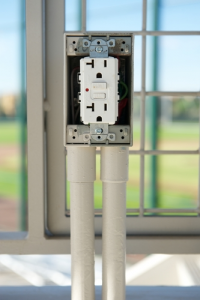People have gotten used to having a ground fault interrupter in kitchens, bathrooms, and outdoors. Every three years, when the newest National Electrical Code comes out, there’s usually a new location added to the list. For your own safety—and before you get a home inspection—check to see if you have a Ground Fault Interrupter (GFI) outlet or breaker in all the right places.
Do All Outlets Need GFI?
 After hearing where a ground fault interrupter is required, you might look around and notice that you have normal wall outlets all over a room that needs protection. Don’t panic, because you might not need to make any changes.
After hearing where a ground fault interrupter is required, you might look around and notice that you have normal wall outlets all over a room that needs protection. Don’t panic, because you might not need to make any changes.
An outlet can have ground fault interrupter protection in one of three ways:
- A GFI outlet, which will have test and reset buttons
- A normal outlet that is further down the line from a GFI outlet
- Any outlet on a circuit that has a GFI breaker
You can easily check whether a GFI outlet is properly wired to the non-GFI outlets in the room. Run an appliance on a plain outlet and hit the test button on the GFI outlet—if the appliance shuts off, that outlet has protection.
Wiring Outlets to a GFI Outlet
A GFI outlet protects other outlets downstream from it, if it’s wired correctly for the task. You would need to have the wiring run from the “load” side of the GFI outlet to the next outlet. If the wiring runs from the “line” side, the other outlets are not served by the ground fault interrupter!
When Is a GFI Breaker More Convenient?
In many situations, using a GFI outlet makes the most sense. If there’s a ground fault, you can fix the problem and reset the outlet right there. You can test the outlet whenever you want without having to go to the breaker panel.
However, you can get the same protection from a ground fault interrupter at the circuit breaker. Some people prefer a GFI breaker just to be safe and certain that all required locations get protected.
Others enjoy the fact that a GFI breaker lets you keep whatever kind of outlets you have in place. If you’ve found the perfect shade of dark brown electrical outlet to match your wall, you probably don’t want to switch it out with a white or tan GFI outlet. On tile backsplashes and other areas that you don’t want to disturb, it’s also easier to use a ground fault interrupter at the breaker.
Not the Only Protection You Need
A ground fault interrupter reduces the risk of shock injury, which is more common in wet places. Be aware that GFI outlets and breakers do not protect against house fires, power surges, or other electrical problems.
You also need:
- Arc fault interrupters: Required in bedrooms and living rooms, an AFCI breaker cuts off power when it detects an arc fault (stray electricity or sparks that can catch fire).
- Surge protection: Recommended for any home with computers, televisions, and smart appliances (so, basically everyone these days). A whole-house surge protector keeps your electronics from getting fried by power surges that come from inside or outside of the home.
Add a Ground Fault Interrupter
A GFI breaker won’t do any good if wired improperly. Ask a licensed electrician to check if you’re up to code and install a ground fault interrupter breaker or replace outlets as necessary. To schedule an electrical inspection in the Santa Rosa area, contact us online.

